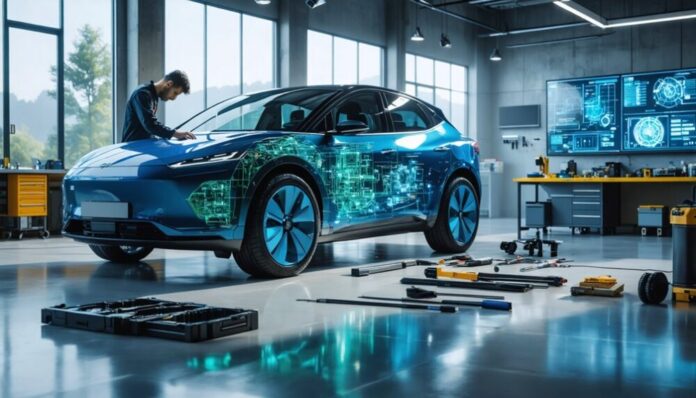Hybrid vehicle maintenance involves routine inspections, oil changes, and brake checks similar to traditional cars, but requires additional attention to battery health and regenerative braking systems. Key aspects include understanding battery longevity and warranty coverage, recognizing warning signs, and ensuring technicians have specialized training. Regular upkeep not only enhances performance but also supports eco-friendly initiatives. There are many more perspectives about hybrid maintenance that can further improve ownership experiences and sustainability.
Highlights
- Regular oil changes are essential, typically occurring every 7,500-10,000 miles, just like traditional vehicles.
- Hybrid batteries can last 15-20 years with proper maintenance but typically require replacement around 100,000 miles.
- Routine inspections of regenerative braking systems and electrical components prevent costly failures and enhance safety.
- Regenerative braking reduces wear on brake components, extending their lifespan by 30-50%.
- Employing certified technicians ensures compliance with safety regulations and mastery of hybrid-specific maintenance practices.
Maintenance Schedule Similarities
While they incorporate advanced technology, hybrid vehicles exhibit maintenance schedule similarities to traditional gasoline cars, making their upkeep less intimidating for owners. Particularly, hybrids require regular oil changes, with intervals extending to 7,500-10,000 miles, unlike the 5,000-mile standard for conventional vehicles. This enhanced fuel efficiency contributes to longer-lasting oil. Brake systems also share common maintenance schedules; however, regenerative braking enables longer-lasting brake pads, often exceeding 100,000 miles. Routine coolant checks and tire rotations are essential as well, reflecting conventional vehicle practices. Owners can manage vehicle registration and maintenance requirements confidently, knowing that hybrid upkeep mirrors traditional cars, thereby promoting a sense of belonging among enthusiasts and those new to hybrid technology. Additionally, the hybrid vehicle design contributes to reduced maintenance needs, as fewer moving parts lead to lower service frequency. This is aided by the fact that hybrid vehicles experience less wear and tear on major engine components due to the electric motor taking over at low speeds and during idling. Furthermore, regular maintenance practices, like battery maintenance, are crucial for ensuring the longevity of hybrid systems.
Battery System Requirements
As hybrid vehicles gain popularity, understanding their battery system requirements becomes essential for both prospective buyers and current owners. Effective battery design varies among models, where configurations like the Toyota Prius NHW-11 employ 38 prismatic batteries, achieving a system voltage of 319.2V. Performance requirements specify a maximum operating voltage of 400Vdc and a careful state of charge maintained between 30-80% for longevity. Additionally, modern charging systems need to support both nickel-metal hydride and lithium-ion batteries, with the latter gaining favor due to higher energy density. The survival temperature range and self-discharge rates are critical aspects ensuring reliability. Moreover, it is important to consider that hybrid batteries typically last around 15-20 years, which can greatly influence maintenance planning. Compliance with battery-related requirements ensures that hybrid vehicles maintain optimal performance standards. Awareness of these specifications enables hybrid owners to make informed decisions about their vehicle’s maintenance and performance. Furthermore, understanding the nominal voltage of modern NiMH batteries, which stands at 7.2V, can help determine charging requirements.
Brake System Advantages
The adoption of hybrid vehicles brings significant advantages to their braking systems, primarily through the implementation of regenerative braking technology. This innovative approach reduces wear on brake components, allowing brake pads to experience minimal contact with rotors during normal driving. Consequently, the lifespan of traditional brake parts can extend by 30-50%, resulting in fewer replacements and lower maintenance costs. Regenerative braking not only enhances brake durability by decreasing friction-based heat generation but also guarantees smoother deceleration, seamlessly integrating with friction braking systems. Additionally, regenerative braking captures kinetic energy during braking, contributing to charging the vehicle’s battery and improving overall efficiency. Moreover, this system improves vehicle efficiency by recovering energy that would otherwise be wasted, further benefiting both the environment and the driver’s wallet. Furthermore, regenerative braking technology is a key component in maximizing fuel efficiency, leading to enhanced driving experiences for eco-conscious consumers. Drivers enjoy improved control in various conditions, while reduced brake dust accumulation contributes to a cleaner vehicle. Overall, hybrid braking systems offer both performance and longevity, creating a persuasive case for eco-conscious consumers seeking reliable transportation.
Technician Qualifications
Achieving a high level of proficiency in hybrid vehicle maintenance necessitates a diverse set of qualifications for technicians. Technicians are often required to obtain Automotive Service Excellence (ASE) certification, particularly in Automotive Electrical/Electronic Systems, alongside achieving specialized ASE (L3) certification for Light Duty Hybrid/Electric Vehicles. Training programs typically include hands-on experience with high-voltage systems, ensuring technicians are adept in safety procedures and emergency protocols. Furthermore, foundational automotive knowledge is vital, with emphasis on electrical systems and hybrid-specific diagnostics. Pursuing a Hybrid/Electric Vehicle Repair Technician Technical Certificate is also advisable to solidify specialization. Ultimately, these certification requirements and structured training programs equip technicians with the skills needed to excel in the changing scene of hybrid vehicle maintenance. Additionally, specialized training equips candidates with knowledge and skills to handle high-voltage systems, battery technology, and electric drivetrains. As the industry grows, demand for skilled technicians will continue to increase, further highlighting the importance of these specialized qualifications.
Warning Signs and Diagnostics
Recognizing warning signs in hybrid vehicles is crucial for maintaining ideal performance and preventing costly repairs. Dashboard warning lights, such as the “Check Hybrid System,” indicate potential hybrid issues, including battery malfunctions. Ignoring these alerts may lead to cascading system failures, complicating future repairs. A noticeable decrease in fuel efficiency can also signal underlying problems, particularly with the hybrid battery. Moreover, problems with hybrid systems can often be identified early through proper maintenance and timely evaluations. Unusual noises, like humming or grinding, may reveal issues with hybrid components, while abnormal smells and vibrations should never be ignored. Using diagnostic tools, such as an OBD2 scanner, allows for early detection and clarification of trouble codes. Regular monitoring and prompt professional evaluations are essential in avoiding extensive damage to hybrid systems and ensuring safe driving experiences. Additionally, the use of Electric Hybrid Vehicle Maintenance Signs can enhance safety by clearly indicating the potential risks and necessary precautions associated with hybrid maintenance. These signs effectively communicate the presence of energized systems to ensure that proper caution is exercised during maintenance.
Longevity and Warranty Facts
A thorough understanding of hybrid vehicle longevity and warranty facts is essential for owners looking to maximize their investment. Hybrid battery life generally spans between 80,000 to 100,000 miles, with many users reporting lifespans reaching up to 200,000 miles through diligent care. Warranties typically cover the initial battery life period, making it wise to budget for a new battery as the vehicle nears the 100,000-mile mark. These vehicles can achieve an impressive lifespan of 10 to 20 years, surpassing traditional gas-powered counterparts due to their efficient design. Factors such as driving conditions, style, and regular maintenance play vital roles in maintaining hybrid durability. Additionally, the maintaining of proper servicing extends the lifespan of the hybrid car, equipping owners with knowledge to enhance the longevity of their hybrids confidently, and such factors are also pivotal in this context. Frequent drivers may need to replace batteries at the five-year mark when properly maintained, reinforcing the importance of regular check-ups and care.
Importance of Regular Inspections
Regular inspections are essential for maintaining the performance and safety of hybrid vehicles, guaranteeing that both their electric and gasoline components operate efficiently. Exhaustive checks, as mandated by NHTSA, safeguard vehicle safety by identifying potential fire risks associated with propulsion batteries. Additionally, routine assessments of regenerative braking systems and high-voltage electrical components can prevent costly failures and enhance driver education on proper maintenance practices. Addressing oil changes and conducting coolant inspections are also essential for the longevity of the internal combustion engine. Employing trained technicians with specialized knowledge guarantees compliance with developing safety regulations. Thus, consistent inspections not only promote a safer driving experience but also nurture a community of informed drivers who prioritize the integrity of their hybrid vehicles. Regular maintenance and inspections can significantly improve fuel efficiency in hybrid cars, making them an even more eco-friendly option. In this context, trained technicians are crucial as they understand the specialized techniques needed for electric vehicle repair. Furthermore, proper battery maintenance is critical as it ensures the longevity and performance of the advanced batteries utilized in hybrid systems.
Eco-Friendly Aspects of Hybrid Vehicles
Hybrid vehicles stand out as an attractive solution for those seeking eco-friendly transportation options.
They substantially contribute to emission reduction, producing 30% less CO2 compared to conventional vehicles.
In electric-only modes, hybrids emit zero tailpipe pollutants, especially beneficial in urban traffic.
Their fuel efficiency is notable, utilizing energy effectively and employing regenerative braking to minimize waste.
The lifecycle emissions profile of hybrids remains favorable, as their smaller battery sizes lead to lower manufacturing impacts and avoid electricity generation penalties faced by plug-in electric vehicles.
Additionally, they decrease harmful pollutants like methane and nitrous oxide.
Cost Considerations for Hybrid Maintenance
The increasing adoption of hybrid vehicles has prompted interest not only in their eco-friendly features but also in the associated maintenance costs.
Projections indicate that maintenance expenses for models like the 2025 Honda CR-V Hybrid reach about $5,642 over five years, while the 2025 Toyota Corolla Hybrid is estimated at $4,163.
Despite initial costs, regenerative braking and reduced engine strain enhance fuel efficiency and lead to lower routine maintenance costs.
Additionally, the long warranty coverage alleviates concerns about expensive repairs.
The reduced brake wear and extended oil change intervals contribute to overall cost savings, making hybrids appealing.
As more repair facilities accept specialized hybrid services, owners can expect accessible maintenance options and a supportive community of fellow hybrid enthusiasts.
References
- https://www.crowntoyota.com/blogs/5040/hybrid-maintenance-unveiling-the-myths-and-realities
- https://goodworksautorepair.com/blog/5-hybrid-maintenance-tips-you-should-never-ignore/
- https://www.firestonecompleteautocare.com/blog/maintenance/maintaining-hybrid-cars/
- https://www.youtube.com/watch?v=QmupOAmWwzU
- https://naylorsautorepairidaho.com/blog/maintenance-tips-hybrid-vehicles
- https://www.mangoautomotive.com/a-local-guide-to-hybrid-car-maintenance-in-albuquerque-by-mango-automotive
- https://afdc.energy.gov/vehicles/electric-maintenance
- https://www.consumerreports.org/cars/hybrids-evs/hybrids-101-guide-to-hybrid-cars-a4638265854/
- https://www.mclaughlinford.com/blogs/2551/ford/hybrid-vehicle-maintenance/
- https://www.wiscassetford.com/blogs/2805/hybrid-vehicle-maintenance/


